- 월가서 금리 우려 증폭…골드만 "10년물 4.3%, 증시 트리거선"
- 미국 채권 금리가 꿈틀하며 상승세를 보이는 가운데 월가에서도 우려의 목소리가 나오고 있다.22일(현지시간) 연합인포맥스(화면번호 7219)에 따르면 이날 미국 10년물 채권 금리는 장 중 한때 4.2%를 돌파했다. 10년물 금리가 4.2%를 웃돈 것은 지난 7월 말 이후 처음이다.미국 연방준비제도(Fed·연준)의 금리 인하 속도가 다른 주요국 중앙은행들보다 느려질 수 있다는 전망이 힘을 얻으면서 채권 금리가 올라가고 있다.시장에서는 채권 금리가 현 수준에서 더 상승할 것이라는 전망이 제기됐다.온라인 경제언론 제로헷지(zerohed

Yesterday, the US stock market saw a considerable decline, particularly in Nasdaq technology stocks, and today, the domestic stock market followed suit, with Samsung Electronics and others experiencing sharp drops, leading to a general downward trend.
At the heart of this was Goldman Sachs' investment letter, which was discussed as an issue during yesterday's US market trading hours.
Recently, concerns about a surge in government bond issuance and high tariffs if Trump is re-elected, coupled with concerns about tax cuts, have led to a sharp rise in market interest rates, particularly in long-term bonds in the US. This impacted the US stock market yesterday.
In their letter, Goldman Sachs cited past research indicating that rapid fluctuations in the 10-year Treasury yield exceeding 2 standard deviations in the short term negatively affect the stock market. They argued that if the 10-year Treasury yield, currently at 4.2%, surpasses 4.3%, it could act as a trigger for market instability.
Looking at the daily chart of the 10-year Treasury yield below, we see it's currently approaching the 4.3% level, the trigger point mentioned by Goldman Sachs. Today, however, due to the post-market surge in Tesla's stock price following its earnings announcement, the Treasury yield is slightly down compared to yesterday, a trend also reflected in Nasdaq futures.
And if it surpasses 4.3%, I believe it would immediately challenge the 4.5% line, which I consider to be an even more sensitive level. Therefore, the 4.3% line plays a crucial role as a precursor to that.
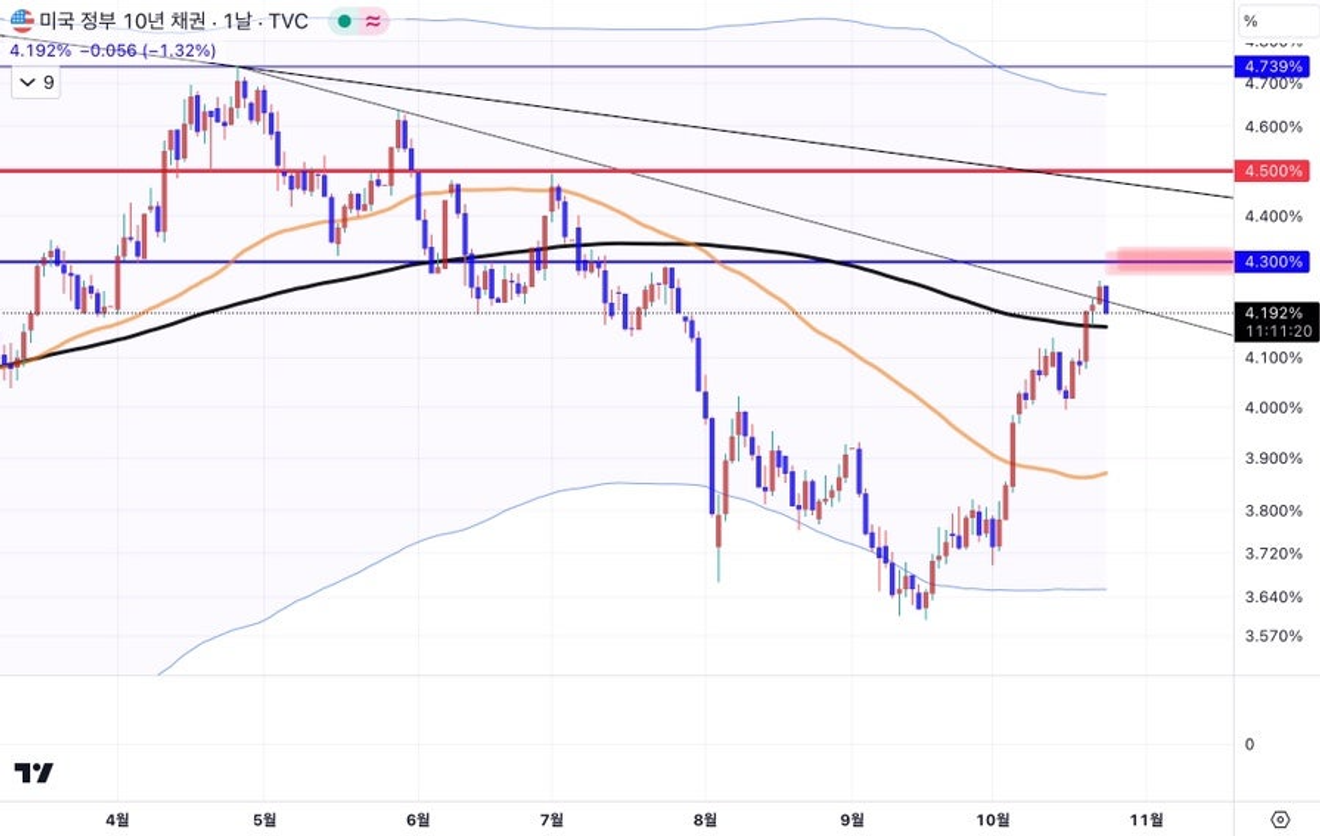
With market interest rates, particularly in long-term bonds, rising continuously recently, it brings to mind something from early last year—March 2022, and the collapse of the US regional banks, often referred to as the SVB crisis.
At that time, the Federal Reserve's quantitative tightening was lowering the overall level of bank reserves. This led to a sudden surge in concerns about "unrealized losses" on the long-term bonds (Treasury bonds) held by many regional banks.
Rumors spread that a significant number of banks held a high proportion of unrealized losses on long-term Treasury bonds in their total assets. This triggered a series of bank runs at many regional banks, leading to the rapid collapse of several, including SVB Financial. The news below shows that tensions eased later as regional banks significantly reduced their bond holdings.
Even after the wave of regional bank failures due to unrealized losses on long-term Treasury bonds subsided, towards the end of last year, as market interest rates continued to rise, news emerged that even major banks had considerable unrealized losses.

In the first half of this year, we also saw news of unrealized losses at major banks like Bank of America (BoA). However, since holding Treasury bonds as part of a bank's assets is normal, the issue isn't the fact that they hold them, but rather whether the proportion held is excessively high during periods of sharp or excessive increases in market interest rates.

The chart below shows the trend of the proportion of securities assets—likely consisting of Treasury bonds, corporate bonds, and MBS—within the total assets of US banks, categorized by size (large/small).
Blue represents large banks, red represents small (regional) banks, and the yellow line shows the trend of the 10-year Treasury yield for comparison.
Looking at small banks, we see that, unfortunately, they significantly increased their bond holdings in 2021, before the sharp rise in interest rates by the Fed following the COVID-19 pandemic. With the sudden surge in cash (reserves) due to the Fed's unlimited quantitative easing during the pandemic, they likely invested a significant portion into long-term bonds. This subsequently led to the crisis last year.
In the beginning of 2023, immediately after the regional banking crisis, small banks drastically reduced their bond holdings. The 10-year Treasury yield didn't drop significantly during that period, so it's likely they sold at a loss.
In any case, to ensure stability, even if it meant taking a loss on bonds, small banks have reduced their bond holdings to approximately pre-COVID-19 pandemic levels. Large banks had been steadily reducing their holdings since before the regional banking crisis, so their proportion wasn't particularly high.
Currently, since the latter half of this year, with the effects of recent interest rate cuts, both large and small banks have slightly increased their bond holdings, but the proportion remains significantly lower than in early 2022.
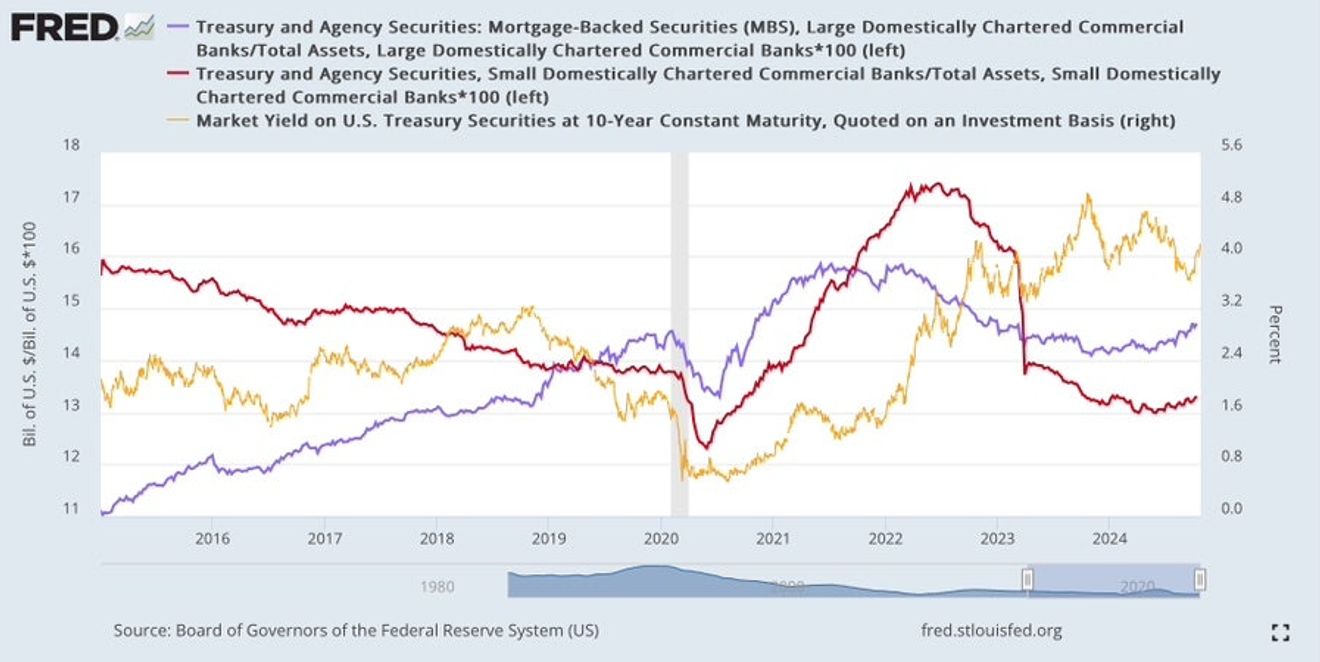
Proportion of Government Bonds and Securities Assets by Bank Size and Trend of 10-Year Treasury Yields
The following chart shows the trend of the proportion of cash (reserves) assets for each bank size category.
Naturally, it shows the opposite trend, influenced by changes in bond holdings. What stands out here is that in recent months, small banks have gradually increased their cash holdings, while large banks have gradually decreased them.
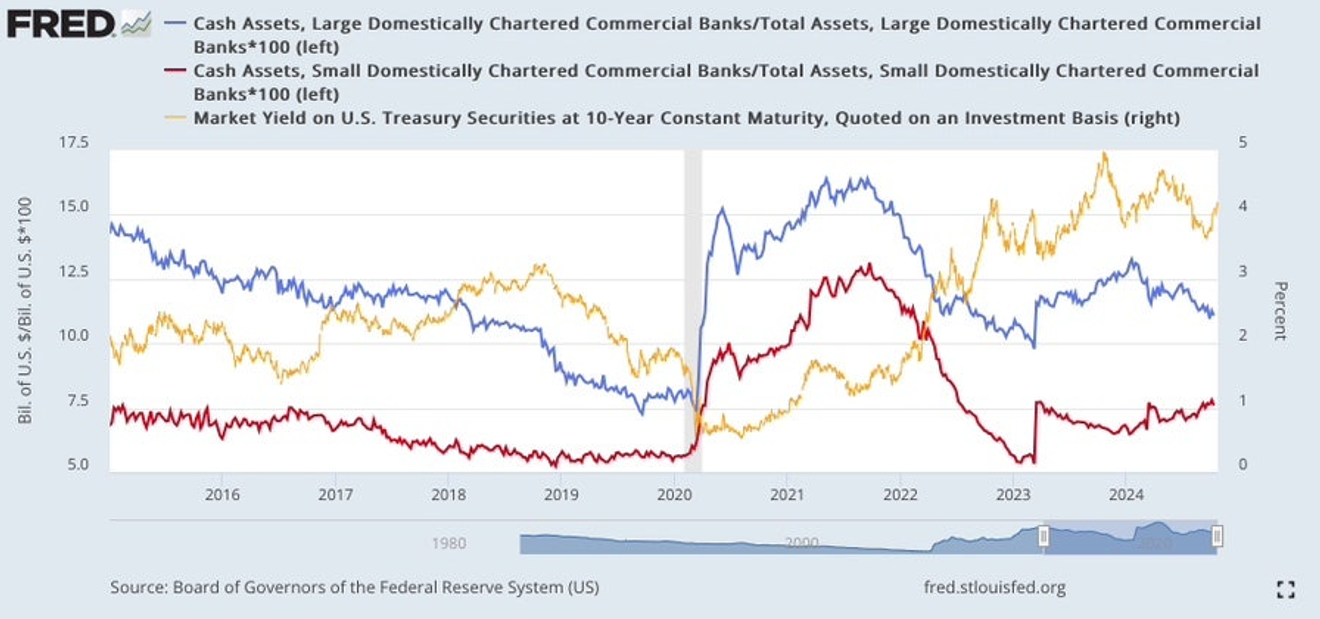
Proportion of Cash by Bank Size and Trend of 10-Year Treasury Yields
Looking at the trend of the Federal Reserve's liability accounts below, we see that since early this year, overall bank reserves have been slowly declining due to quantitative tightening.
Considering this trend in total reserves, both large and small banks are showing a gradual downward trend, which isn't unusual. However, the opposing trends between large and small banks are noteworthy.
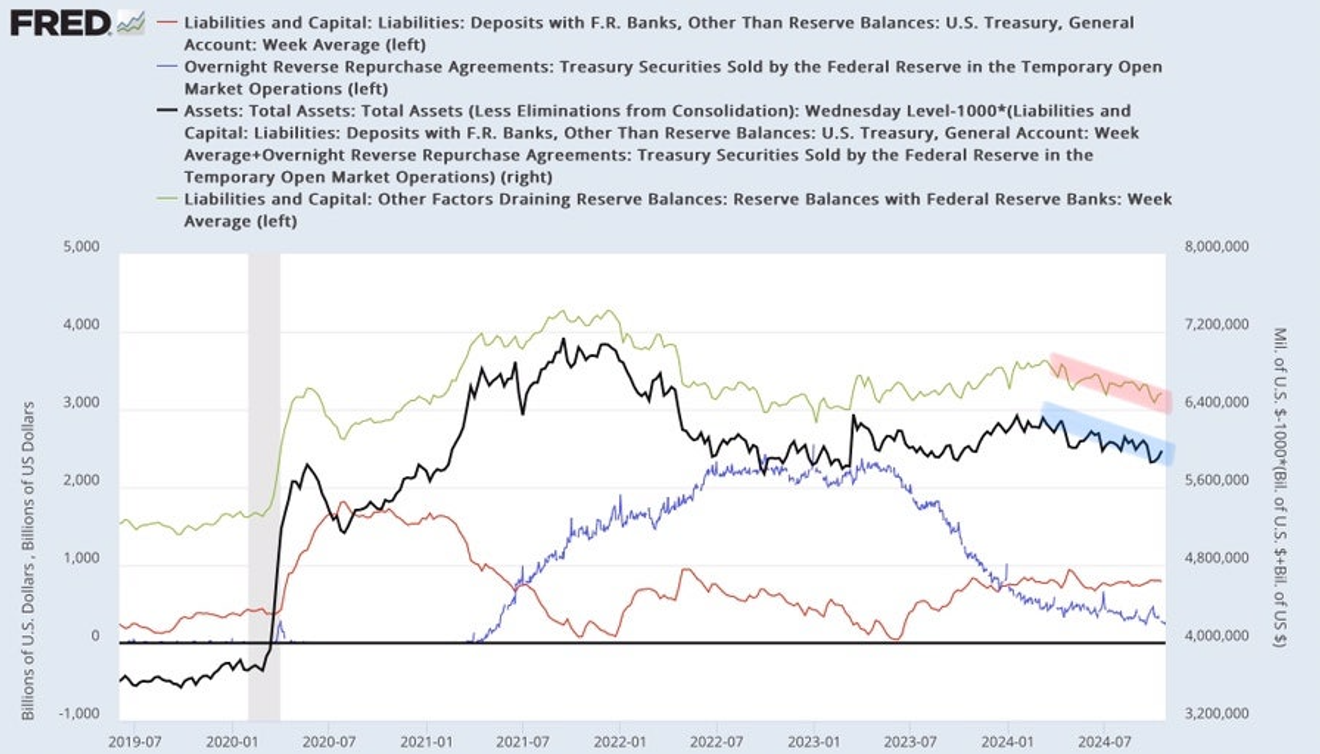
Trend of Federal Reserve Net Liquidity and Liability Accounts: Net Liquidity (Black), Reserves (Green), TGA (Red), RRP (Blue)
The chart below shows the trend of external borrowing for each bank size category, along with the size of the Bank Term Funding Program (BTFP), a lending program the Federal Reserve implemented during the regional banking crisis, and the amount of loans through the discount window (DW).
The discount window is still rarely used by banks, so its scale remains small. The BTFP is gradually decreasing since early this year. Since the loans extended under the BTFP, which were extended late, will all mature in March of next year, banks that don't need additional cash and are not feeling insecure are repaying their loans.
Looking only at small banks, there doesn't seem to be anything particularly unusual or negative about the trend. The surge in external borrowing before and after the regional banking crisis is gradually decreasing as shown below. As seen above, the proportion of cash assets in total assets is increasing. It seems that one year after the regional banking crisis, anxiety among depositors about small regional banks has subsided, deposits are increasing, external borrowing is decreasing, etc.
But I'm curious what large banks are doing. Cash holdings are declining slightly, and bond holdings are increasing recently. Looking at this alone, it just seems like they're increasing bond holdings instead of cash, which doesn't seem unusual.
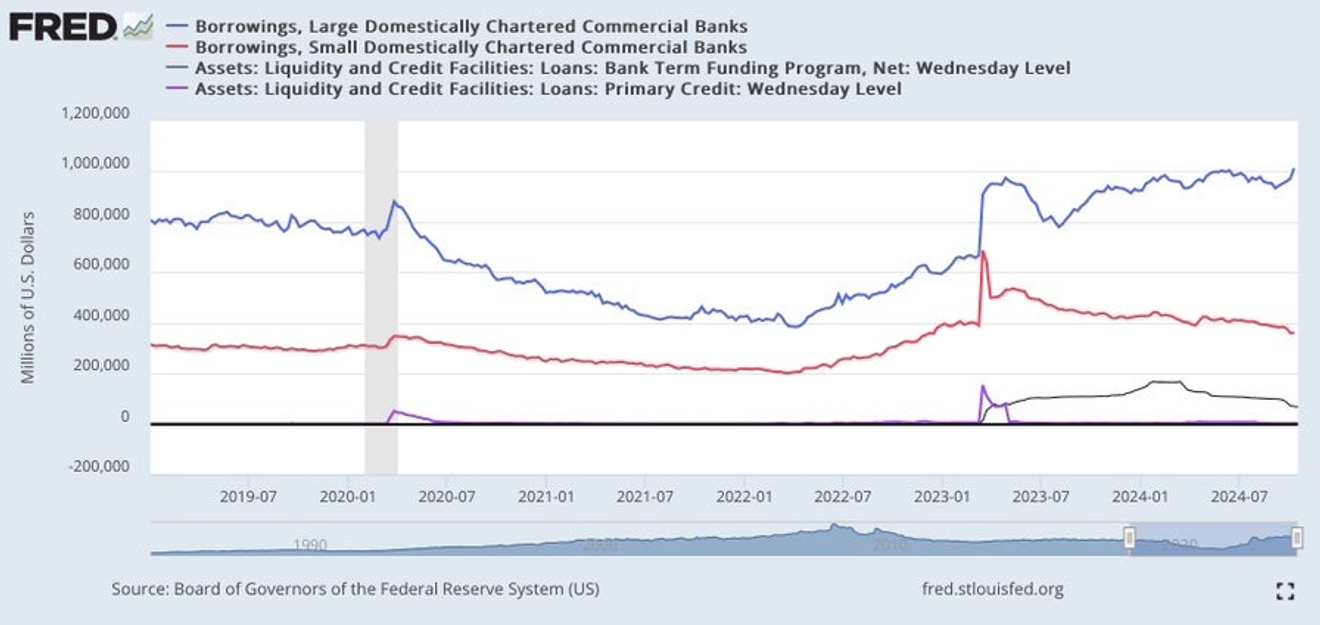
Trend of External Borrowing by Bank Size and BTFP, Discount Window (DW) Loans
However, unlike small banks, there's little sign that they are trying to reduce the amount of external borrowing that they increased after last year's regional banking crisis. Is it because the interest rates on the borrowing are low and the Treasury yields are currently higher, or are they holding onto the borrowing because they expect yields to rise soon?
In any case, looking at the current proportion of cash assets in the banking sector, it doesn't seem that there are any immediate, short-term problems for either large or small banks. Perhaps any problems in the banking sector won't surface until the latter half of next year...


Comments0